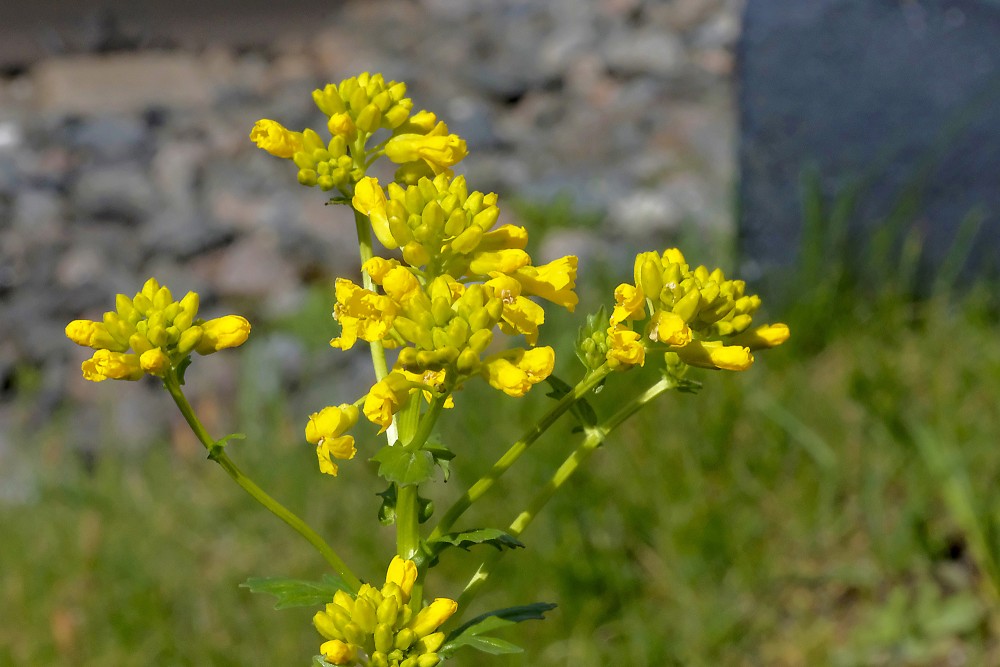Barbarea vulgaris (Herb barbara)
Barbarea vulgaris, also called bittercress, herb barbara, rocketcress, yellow rocketcress, winter rocket, and wound rocket, is a biennial herb of the genus Barbarea, belonging to the mustard family.
| Barbarea vulgaris | |
| Kingdom: | Plantae |
| (unranked): | Angiosperms |
| (unranked): | Eudicots |
| (unranked): | Rosids |
| Order: | Brassicales |
| Family: | Brassicaceae |
| Genus: | Barbarea |
| Species: | B. vulgaris |
Description
This plant grows to about 30–60 cm (12–24 in) high, with a maximum of 1 m (3 ft 3 in). The stem is ribbed and hairless, branched at the base. It has a basal rosettes of shiny, dark green leaves. The basal leaves are stalked and lyre-pinnatifid, that is with a large terminal lobe and smaller lower lobes. The cauline leaves are smaller, ovate, toothed, or lobed. The flowers are borne in spring in dense terminal clusters above the foliage. They are 7–9 mm (0.28–0.35 in) long, with four bright yellow petals. The flowering period extends from about April through July. The fruit is a pod around 15–30 mm (0.59–1.18 in).
Chemical substances in this species include saponins, flavonoids, and glucosinolates.
Taxonomy
It was first published and described by William Aiton in his 'Hortus Kewensis' Vol.4 on page 109 in 1812. Some references mention Robert Brown (Robert Brown (botanist, born 1773)), as the author but there are no mentions of his name in Hortus Kewensis, so Aiton is regarded as the correct author.
It has various common names including 'bittercress', 'cressy-greens', 'herb-Barbaras', 'rocket cress', 'upland cress', 'English wintercress' and 'yellow rocket'.
Etymology
The genus name Barbarea derives from Saint Barbara, the patron saint of artillerymen and miners, as this plant in the past was used to soothe the wounds caused by explosions.[8] The species Latin name vulgaris means “common”.
Natural insect resistance and its potential use in agriculture
Most B. vulgaris genotypes are naturally resistant to some insect species that are otherwise specialized on the crucifer family. In the case of diamondback moth (Plutella xylostella) and the flea beetle Phyllotreta nemorum, the resistance is caused by saponins. Glucosinolates such as glucobarbarin and glucobrassicin are used as a cue for egg-laying by female cabbage white butterflies such as Pieris rapae. Indeed, the larvae of this butterfly thrive well on this plant. Diamondback moth females are also stimulated by these chemicals, but the larvae die due to the content of saponins which are apparently not sensed by the moths. This phenomenon has been tested for biological insect control: B. vulgaris plants are placed in a field and attract much of the diamondback moth egg load. As the larvae die shortly after hatching, this kind of insect control has been named "dead-end trap cropping".
Distribution
Native to Eurasia and North Africa, it is naturalised in many parts of North America and New Zealand as a weed.
Range
It is found in temperate North Africa within Algeria and Tunisia. Also in Asia, within Afghanistan, Armenia, Azerbaijan, the Caucasus, China (in the provinces of Heilongjiang, Jiangsu, Jilin and Xinjiang), Georgia, Iran, Iraq, Japan (in the provinces Hokkaido, Honshu, Kyushu, Ryukyu Islands and Shikoku), Kazakhstan, Kyrgyzstan, Mongolia, Siberia, Tajikistan, Turkmenistan and Turkey. It is also found in tropical parts Asia, such as India (- in the provinces of Sikkim, Himachal Pradesh, Jammu and Kashmir, Tamil Nadu, Uttar Pradesh and Arunachal Pradesh), Pakistan and Sri Lanka.
In eastern Europe, it is found within Belarus, Estonia, Latvia, Lithuania, Moldova and Ukraine. In middle Europe, it is in Austria, Belgium, the Czech Republic, Germany, Hungary, the Netherlands, Poland, Slovakia and Switzerland. In northern Europe, in Denmark, Ireland, Sweden and United Kingdom. In southeastern Europe, within Albania, Bosnia and Herzegovina, Bulgaria, Croatia, Greece, Italy, Macedonia, Montenegro, Romania, Serbia and Slovenia. Lastly, it is found in southwestern Europe, it is found in France, Portugal and Spain.
Habitat
The plant prefers fresh or moist places, on roadsides, along rivers, in arable land, wastelands and docklands, or on the slopes and in ditches, at an altitude of 0–2,500 m (0–8,202 ft) above sea level.
It also prefers to grow in siliceous, calcareous, sandy, alluvial and clay soils.
en.wikipedia.org

